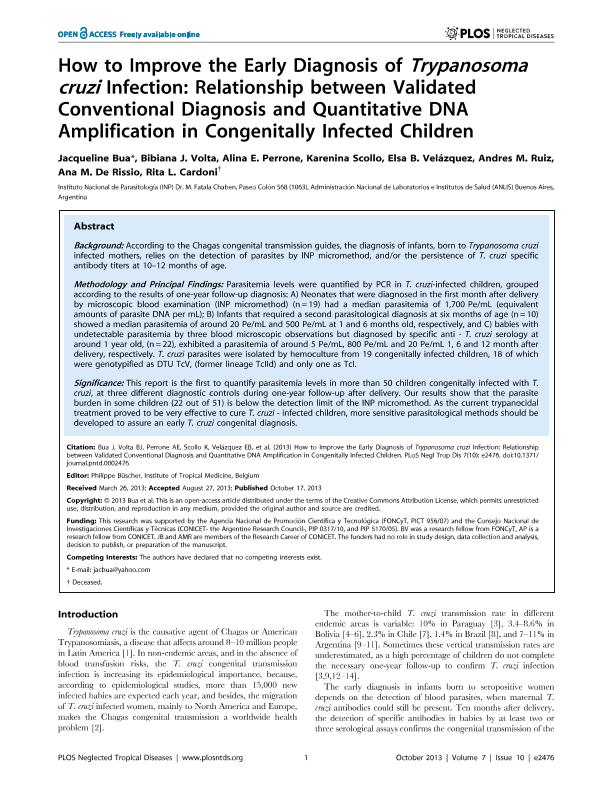Artículo
How to improve the early diagnosis of Trypanosoma cruzi infection: Relationship between validated conventional diagnosis and quantitative DNA amplification in congenitally infected children
Bua, Jacqueline Elena ; Volta, Bibiana Julieta; Perrone, Alina Elizabeth
; Volta, Bibiana Julieta; Perrone, Alina Elizabeth ; Scollo, Karenina; Velázquez, Elsa Beatriz
; Scollo, Karenina; Velázquez, Elsa Beatriz ; Ruiz, Andrés Mariano
; Ruiz, Andrés Mariano ; de Rissio, Ana María; Cardoni, Rita Liliana
; de Rissio, Ana María; Cardoni, Rita Liliana
 ; Volta, Bibiana Julieta; Perrone, Alina Elizabeth
; Volta, Bibiana Julieta; Perrone, Alina Elizabeth ; Scollo, Karenina; Velázquez, Elsa Beatriz
; Scollo, Karenina; Velázquez, Elsa Beatriz ; Ruiz, Andrés Mariano
; Ruiz, Andrés Mariano ; de Rissio, Ana María; Cardoni, Rita Liliana
; de Rissio, Ana María; Cardoni, Rita Liliana
Fecha de publicación:
06/2013
Editorial:
Public Library of Science
Revista:
Neglected Tropical Diseases
ISSN:
1935-2735
Idioma:
Inglés
Tipo de recurso:
Artículo publicado
Clasificación temática:
Resumen
BACKGROUND: According to the Chagas congenital transmission guides, the diagnosis of infants, born to Trypanosoma cruzi infected mothers, relies on the detection of parasites by INP micromethod, and/or the persistence of T. cruzi specific antibody titers at 10-12 months of age. METHODOLOGY AND PRINCIPAL FINDINGS: Parasitemia levels were quantified by PCR in T. cruzi-infected children, grouped according to the results of one-year follow-up diagnosis: A) Neonates that were diagnosed in the first month after delivery by microscopic blood examination (INP micromethod) (n = 19) had a median parasitemia of 1,700 Pe/mL (equivalent amounts of parasite DNA per mL); B) Infants that required a second parasitological diagnosis at six months of age (n = 10) showed a median parasitemia of around 20 Pe/mL and 500 Pe/mL at 1 and 6 months old, respectively, and C) babies with undetectable parasitemia by three blood microscopic observations but diagnosed by specific anti - T. cruzi serology at around 1 year old, (n = 22), exhibited a parasitemia of around 5 Pe/mL, 800 Pe/mL and 20 Pe/mL 1, 6 and 12 month after delivery, respectively. T. cruzi parasites were isolated by hemoculture from 19 congenitally infected children, 18 of which were genotypified as DTU TcV, (former lineage TcIId) and only one as TcI. SIGNIFICANCE: This report is the first to quantify parasitemia levels in more than 50 children congenitally infected with T. cruzi, at three different diagnostic controls during one-year follow-up after delivery. Our results show that the parasite burden in some children (22 out of 51) is below the detection limit of the INP micromethod. As the current trypanocidal treatment proved to be very effective to cure T. cruzi - infected children, more sensitive parasitological methods should be developed to assure an early T. cruzi congenital diagnosis.
Palabras clave:
Chagas Disease
,
Congenital Transmission
,
Quantitative Pcr
Archivos asociados
Licencia
Identificadores
Colecciones
Articulos(SEDE CENTRAL)
Articulos de SEDE CENTRAL
Articulos de SEDE CENTRAL
Citación
Bua, Jacqueline Elena; Volta, Bibiana Julieta; Perrone, Alina Elizabeth; Scollo, Karenina; Velázquez, Elsa Beatriz; et al.; How to improve the early diagnosis of Trypanosoma cruzi infection: Relationship between validated conventional diagnosis and quantitative DNA amplification in congenitally infected children; Public Library of Science; Neglected Tropical Diseases; 7; 10; 6-2013; 1-6; e2476
Compartir
Altmétricas



